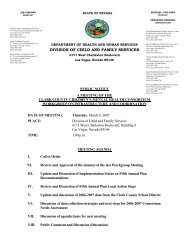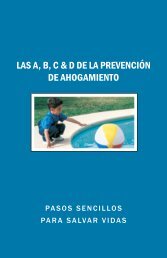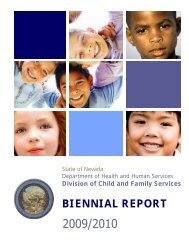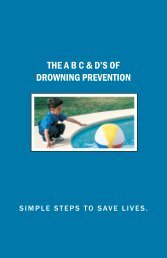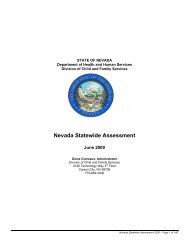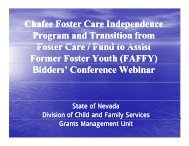STATE OF NEVADA - Division of Child and Family Services
STATE OF NEVADA - Division of Child and Family Services
STATE OF NEVADA - Division of Child and Family Services
Create successful ePaper yourself
Turn your PDF publications into a flip-book with our unique Google optimized e-Paper software.
Caseworker-<strong>Child</strong> Contact report is reviewed monthly with supervisors <strong>and</strong> managers to identify trends, barriers <strong>and</strong><br />
solutions.<br />
The Clark County Department <strong>of</strong> <strong>Family</strong> <strong>Services</strong> (CCDFS) opened a <strong>Family</strong> Visitation Center in February 2008. The new<br />
visitation center is open seven days a week, including holidays, from 8 a.m. to 8 p.m. The center is staffed full time <strong>and</strong><br />
has vehicles available for transportation in an effort to provide flexibility <strong>and</strong> support to parents <strong>and</strong> their children during<br />
visitation activities. The <strong>Family</strong> Visitation Center is designed to promote meaningful visitation between children <strong>and</strong> their<br />
caregivers in a safe, child- <strong>and</strong> family-friendly setting that is conducive to assessing parent-child interaction.<br />
Item 20: Caseworker visits with parents<br />
Goal: To determine whether the frequency <strong>and</strong> quality <strong>of</strong> visits between caseworkers <strong>and</strong> the mothers <strong>and</strong> fathers <strong>of</strong> the<br />
children are sufficient to ensure the safety, permanency, <strong>and</strong> well-being <strong>of</strong> the children <strong>and</strong> promote achievement <strong>of</strong> case<br />
goals.<br />
To achieve this goal, the State must ensure that the frequency <strong>and</strong> quality <strong>of</strong> visits between the caseworker <strong>and</strong> mother<br />
<strong>and</strong> father are sufficient to address issues pertaining to the safety, permanency, <strong>and</strong> well-being <strong>of</strong> the child <strong>and</strong> promote<br />
the achievement <strong>of</strong> case goals <strong>and</strong> that these visits, including the typical pattern <strong>of</strong> visitation, are appropriately<br />
documented in UNITY in a minimum <strong>of</strong> 90% <strong>of</strong> cases. Data from the 2009 CFSR, as shown in Table 29 below indicates<br />
that Nevada is currently not meeting this goal <strong>and</strong> that this is an area needing improvement.<br />
Table 29: SFY 2010 Data for Item 20<br />
Item 20: Worker visits with parents CFSR 2009 NV Goal Goal Met<br />
Statewide 44% 90%* No<br />
Clark County 27% 90%* No<br />
Washoe County 64% 90%* No<br />
DCFS Rural Region 50% 90%* No<br />
*Unless otherwise negotiated or if exceeds federal requirements<br />
Well-Being Outcome 2: <strong>Child</strong>ren receive appropriate services to meet their educational needs.<br />
Item 21: Educational needs <strong>of</strong> child<br />
Goal: To assess whether the State is making concerted efforts to assess children’s educational needs at the initial<br />
contact with the child <strong>and</strong> on an ongoing basis, <strong>and</strong> whether identified needs were appropriately addressed in case<br />
planning <strong>and</strong> case management activities.<br />
To meet this goal, the State must ensure that an assessment <strong>of</strong> the educational <strong>and</strong>/or developmental needs <strong>of</strong> each child<br />
in care according to the requirements in statewide policy is conducted <strong>and</strong> that appropriate services are provided in a<br />
minimum <strong>of</strong> 90% <strong>of</strong> cases. This is an area that is a particular strength for Nevada. In the 2009 Nevada CFSR, the State<br />
achieved a rating <strong>of</strong> 95% <strong>and</strong> all child welfare agencies rated above 90% (see Table 30). The child welfare agencies<br />
have initiated a variety <strong>of</strong> methods to ensure that the educational needs <strong>of</strong> children are met. These include educational<br />
liaisons with the schools, referrals to Nevada Early Intervention <strong>Services</strong>, <strong>and</strong> tracking <strong>of</strong> children’s progress while in the<br />
school system. These areas are outlined more fully in the Initiatives section above.<br />
Table 30: SFY 2010 Data for Item 21<br />
Item 21: Educational needs <strong>of</strong> the child CFSR 2009 NV Goal Goal Met<br />
Statewide 95% 90%* Yes<br />
Clark County 95% 90%* Yes<br />
Washoe County 100% 90%* Yes<br />
DCFS Rural Region 92% 90%* Yes<br />
*Unless otherwise negotiated or if exceeds federal requirements<br />
Educational Stability: In relation to educational stability, Policy 0204 Case Planning was updated in January 2010 <strong>and</strong><br />
formerly approved in April 2010 to reflect the promoting educational stability <strong>of</strong> the Fostering Connections to Success <strong>and</strong><br />
Increasing Adoptions Act <strong>of</strong> 2008 (PL 110-351 language. This update has been approved by the DMG <strong>and</strong> there is<br />
Nevada APSR – SFY 2010<br />
Page 43 <strong>of</strong> 108



